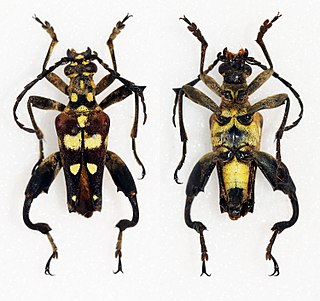
Bimiini is a tribe of beetles in the subfamily Cerambycinae, containing the following genera and species:
Ariastes is a genus in the longhorn beetle family Cerambycidae. There are at least two described species in Ariastes, found in Madagascar.
Barossus is a genus in the longhorn beetle family Cerambycidae described by Fairmaire in 1893. There are at least two described species in Barossus, found in Madagascar.
Criocerinus is a genus in the longhorn beetle family Cerambycidae. There are at least two described species in Criocerinus, found in Madagascar.
Eccrisis is a genus in the longhorn beetle family Cerambycidae. There are about 19 described species in Eccrisis, found in Madagascar.
Echaristha is a genus in the longhorn beetle family Cerambycidae. There are at least two described species in Echaristha, found in Madagascar.
Gaurotinus is a genus in the longhorn beetle family Cerambycidae. There are at least two described species in Gaurotinus, found in Madagascar.
Icariotis is a genus of Long-Horned Beetles in the beetle family Cerambycidae. There are about 15 described species in Icariotis, found in Madagascar.
Logisticus is a genus in the longhorn beetle family Cerambycidae. There are about 18 described species in Logisticus, found in Madagascar.

Mastododera is a genus in the longhorn beetle family Cerambycidae. There are about 11 described species in Mastododera.
Pachysticus is a genus in the longhorn beetle family Cerambycidae. There are about seven described species in Pachysticus, found in Madagascar.
Phitryonus is a genus in the longhorn beetle family Cerambycidae. There are at least two described species in Phitryonus, found in Madagascar.
Scariates is a genus in the longhorn beetle family Cerambycidae. This genus has a single species, Scariates basipennis. It is found in Madagascar.
Scopanta is a genus in the longhorn beetle family Cerambycidae. There are at least three described species in Scopanta, found in Madagascar.
Tomobrachyta is a genus in the longhorn beetle family Cerambycidae. There are at least two described species in Tomobrachyta, found in Madagascar.
Toxitiades is a genus in the longhorn beetle family Cerambycidae. There are about nine described species in Toxitiades, found in Madagascar.
Trichroa is a genus of longhorned beetles in the family Cerambycidae. This genus has a single species, Trichroa oberthueri, found in Madagascar.
Goephanes is a genus of beetles in the family Cerambycidae, containing the following species:
Pseudogenes ornaticeps is a species in the longhorn beetle family Cerambycidae. It is native to Madagascar.

The Apatophyseini are a tribe of longhorn beetles erected by Lacordaire in 1869. They are placed in the monotypic subfamily Apatophyseinae.


